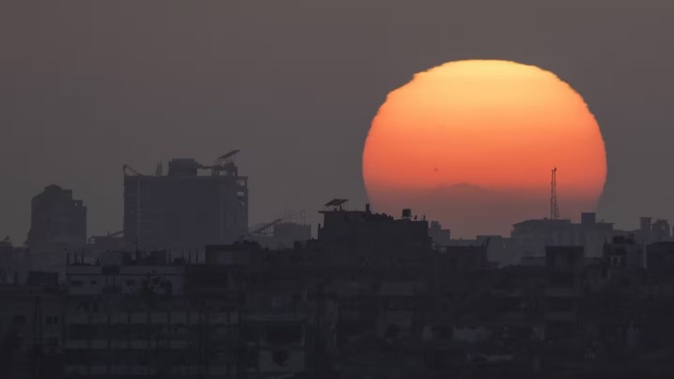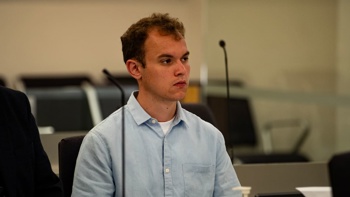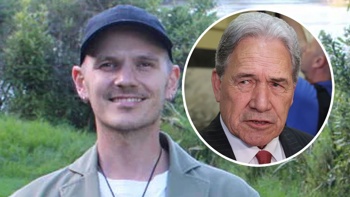
Humanitarian workers have started moving tonnes of aid that piled up at a US-built pier off the Gaza coast to warehouses in the besieged Palestinian territory, the United Nations said on Saturday, an important step as Washington considers whether to resume pier operations after yet another pause because of heavy seas.
It wasn’t known when the aid might reach Palestinians in Gaza, where experts have warned of the high risk of famine as the Israel-Hamas war is in its ninth month. This is the first time trucks have moved aid from the pier since the World Food Programme, a UN agency, suspended operations there because of security concerns on June 9.
In just the last week, more than 10 million pounds were moved ashore, according to the US military.
WFP spokesperson Abeer Etefa told The Associated Press this is a one-time operation until the beach is cleared of the aid and is being done to avoid spoilage. Further UN operations at the pier depend on security assessments, Etefa said. The UN is investigating whether the pier was used in an Israeli military operation last month to rescue three hostages in a raid that killed more than 270 Palestinians.
Palestinians displaced by the Israeli bombardment of the Gaza Strip walk through a street market in Khan Younis, southern Gaza Strip. Photo / AP
If WFP trucks successfully bring the aid to warehouses inside Gaza, that could affect the US military’s decision on whether to reinstall the pier, which was removed because of adverse weather on Friday. US officials said they were considering not reinstalling it because of the possibility that the aid would not be picked up.
Lawlessness around humanitarian convoys is another challenge to aid distribution. The convoys have come under attack in Gaza. While most aid deliveries come by land, restrictions around border crossings and on what items can enter Gaza have further hurt a population that was already dependent on humanitarian aid before the war.
An attempt to revive stalled talks
Meanwhile Saturday, a senior Biden administration official said the US has presented new language to intermediaries Egypt and Qatar aimed at trying to jump-start stalled Israel-Hamas negotiations.
The official, who requested anonymity to discuss the effort that the White House has yet to publicly unveil, said the revised text focuses on negotiations that are to start between Israel and Hamas during the first phase of a three-phase deal that US President Joe Biden laid out nearly a month ago.
The first phase calls for a “full and complete cease-fire,” a withdrawal of Israeli forces from all densely populated areas of Gaza and the release of a number of hostages, including women, older people and the wounded, in exchange for the release of hundreds of Palestinian prisoners.
The proposal called for the parties to negotiate the terms of the second phase during the 42 days of phase one. Under the current proposal, Hamas could release all of the remaining men, both civilians and soldiers. In return, Israel could free an agreed-upon number of Palestinian prisoners and detainees. The releases won’t occur until “sustainable calm” takes effect and all Israeli troops withdraw from Gaza.
The new proposed language, which the official didn’t detail, aims to find a workaround of differences between Israel and Hamas about the parameters of the negotiations between phase one and phase two. Hamas wants negotiations centred on the number and identity of Palestinian prisoners to be released from Israeli jails in exchange for remaining living Israeli soldiers and male hostages held in Gaza, the official said. Israel wants negotiations to be broader and include the demilitarisation of the territory controlled by Hamas.
Hamas political official Osama Hamdan said the group had yet to receive a new ceasefire proposal from mediators. Hamas political leader Ismail Haniyeh spoke by phone with the head of Egypt’s general intelligence service to discuss the negotiations, Hamas said in a statement.
Fighting in Shijaiyah and thousands flee
More than 37,800 Palestinians have been killed in the war since it began with Hamas’ attack on southern Israel on October 7, according to Gaza’s Health Ministry, which doesn’t distinguish between civilians and combatants in its toll. The ministry said the bodies of 40 people killed by Israeli strikes had been brought to local hospitals over the past 24 hours.
At least three people, including a 5-year-old girl, were killed and six others were wounded in a strike in the Bureij refugee camp in central Gaza. The Israeli military didn’t immediately comment.
The October 7 Hamas attack in Israel killed about 1200 people, mostly civilians, and another 250 people were taken hostage.
Israeli forces have been battling Palestinian militants in an eastern part of Gaza City, Shijaiyah, over the last week. Israel’s military on Saturday noted “close-quarters combat.” Tens of thousands of Palestinians have fled their homes, according to the UN.
People protest against Israeli Prime Minister Benjamin Netanyahu's government and call for the release of hostages held in the Gaza Strip by the Hamas militant group, in Tel Aviv, Israel. Photo / AP
“It’s like the first weeks of the invasion,” one resident, Mahmoud al-Masry said of the intensity of the fighting. “Many people were killed. Many houses were destroyed. They strike anything moving.”
Elsewhere, thousands of Palestinians who remained in Gaza’s southernmost city of Rafah fled on Friday for Muwasi, a coastal tent camp designated by the Israeli army as a safe zone. Some told the AP that they evacuated because Israeli gunfire and missiles had come close to where they sheltered.
More than 1.3 million Palestinians have fled Rafah since Israel’s incursion into the city in early May, while aid groups warn there are no safe places to go.
With the heat in Gaza reaching over 32C, many displaced people have found tents unbearable. The territory has been without electricity since Israel cut off power as part of the war, and Israel also stopped pumping drinking water to the enclave.
“Death is better than it. It is a grave,” said Barawi Bakroun, who was displaced from Gaza City, as others fanned themselves with pieces of cardboard.
Take your Radio, Podcasts and Music with you









